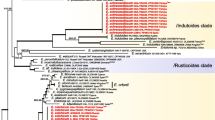Abstract
Although bothAstasia longa andEuglena gracilis belong to different genera, they share many morphological characters except thatA. longa has no chloroplast. In the 1940's, on the basis of the finding that in darkness or upon addition of some chemicals,E. gracilis would fade reversibly or irreversibly, some scholars hypothesised thatA. longa evolved fromE. gracilis by losing chloroplast. The author's use of RAPD and cladistic analyses in a study on the evolutionary relationship between A. longa andE. gracilis showed that theA. longa's relationship withE. gracilis was closer than that with other green euglenoids. This proves the hypothesis thatA. longa evolved fromE. gracilis is reasonable. The results of this study suggest that saprophytic colorless euglenoids were transformed from green euglenoids by losing their choroplasts.
Similar content being viewed by others
References
Beckmann J. S., 1988. Oligonucleotide polymorphisms: a new tool for renomic genetics.Bio. Technology 6: 1061–1064.
Cactno-Anolles, G., Bassam, B. J., Gresshoff, P. M., 1992. Primer-template interactions during DNA amplification fingerprinting with single arbitrary oligonucleotides.Mol. Gen. Genet. 235: 157–165
Chaves, A. L., Vergara, C. E., Mayer, J. E., 1995. Dichloromehtane as an economic alternative to chloroform in the extracton of DNA from plant tissues.Plant Molecular Biology Reporter 13(1): 18–25.
Halward, T., Stalker, T., LaRue, E., et al., 1992. Use of single-primer DNA amplifications in genetic studies of peanut (Arachis hypogaea L.).Plant Molecular Biology 18: 315–325.
Henning, W., 1966. Phylogenetic Systematics. Univ. Of Illinois Press, Urbara: 263.
Hollande, A., 1942. Etude cytologique et biologique de quelques flagelles libres.Arch Zool Exp. Gen.,83: 1–268.
Klebs, G., 1883. Under die organisation einiger Flagellaten-Gruppen und ihre Beziehungen zu anderen Infusorien.Unter Bot Inst Tubingen.1: 233–262.
Patwary, M. U., Mackayon, R. M., Van der Meer, J. P., 1993. Revealing genetic markers inGelidium vagum (Rhodophyta) through the random amplified polymorphic DNA (RAPD) technique.J. Phycol. 29: 216–222.
Peinado, M. A., Malkhosyan, S., Velazquez, A., et al., 1992. Isolation and characterization of allelic losses and gains in colorectal tumors by arbitrarily primed polymerase chain reaction.Proc. Natl. Acad. Sci. USA 89: 10065–10069.
Pringheim, E. G. 1948. Taxonomic problems in the Euglenaneae.Biological Reviews and Biological Proceedings of Cambridge Philosophical Society 23: 46–61.
Pringsheim, E. G., 1956. Contributions towards a monograph of the genusEuglena.Nova Acta Leopoldina.18: 168.
Pringsheim, E. G., 1963. Farblose Algen. Gustav fischer Verlag, Seuttgart, p. 172–222.
Reiter, R. S., Williams, J. G. K., Feldmann, K. A., et al., 1992. Global and local genome mapping inArabidopsis thaliana by using recombinant inbred lines and random amplified polymorphic DNAs.Proc. Natl. Acad. Sci. USA,89: 1477–1481.
Sambrook, J., Fritsch, E. F., Maniatis, T., 1989. Molecular cloning. A laboratory manual. Second Edition. Cold Spring Harbor laboratory Press.
Wang, J. X., Xie, S. L., Zhong, J. Y., et al., 1999. A modified rapid efficient DNA extraction method of euglenoids.Acta Hydrobiologica Sinica 23(5): 533–536.
Welsh, J., Petersen Ch., McClelland M., 1991. Polymorphisms generated by arbitrarily primed PCR in the mouse: application to strain identification and genetic mapping.Nucleic Acids Research 19 (2): 303–306.
Williams, J. G. K., Kubelik, A. R., Livak, K. J., et al., 1990. DNA polymorphism amplified by arbitrary primers are useful as genetic makers.Nucleic Acids Res. 18: 6531–6535.
Xu, K. X., 1989. An algorithm for cladistic taxonomy-method of maximal samestep length.Acta Phytotax. Sinica 27: 232–239.
Xu, K. X., 1993a. An algorithm for cladistic taxonomy-method of minimal parellel evolution.Acta Phytotax. Sinica 31: 578–586.
Xu, K. X., 1993b. An algorithm for cladistic taxonomy-evolutionary extreme aggregation method.Journal of Wuhan (China) Bot. Res. 11: 223–231.
Xu, K. X., 1994. The compatibility concept and compatibility analysis method in cladistic.Acta Phytotax. Sinica.2: 380–388.
Yu Kangfu, Pauls, K. P., 1992. Optimization of the PCR program for RAPD analysis.Nucielc Acids Researches 20: 2606.
Zarkrys, B., 1997a. On the identity and variation ofEuglena agilis Carter (=E. pisciformis Klebs).Algological Studies 86: 81–90.
Zarkrys, B., 1997b. The taxonomic consequences of morphological and genetic variability inEuglena agilis Carter (Euglenophyta): Species or clones inEuglena? Acta Protozoologica 36: 157–169.
Zarkrys, B., Kucharski, R., 1996. Mocroevolutionary processes inEuglena pisciformis. Genetic drift or adaptation?Algological Studies 81: 23.
Zarkrys, B., Kucharski, R., Moraczewski, I., 1996. Genetic and morphological variability among clones ofEuglena pisciformis based on RAPD and biometric analysis.Algological Studies 81: 1–21.
Zarkrys, B., Moraczewski, I., Kucharski, R., 1997. The species concept inEuglena in light of DNA polymorphism analyses.Algological Studies 86: 51–79.
Zarkrys, B., Walne, P. L., 1998a. Comparative ultrastructure of chloroplasts in the subgenusEuglena (Euglenophyta) taxonomic significance.Cryptogamie, Algol. 19(1–2): 3–18.
Zarkrys, B., Walne, P. L., 1998b. Ultrastructure of mucocysts inEuglena axyuris Schmarda (Euglenophyceae).Algological Studies 88: 125–133.
Author information
Authors and Affiliations
Additional information
Project 39570063 supported by NSFC and also by Special Fund of CAS.
Rights and permissions
About this article
Cite this article
Jiang-xin, W., Zhi-xin, S., Xiao-ni, G. et al. Analysis of evolutionary relationship betweenAstasia longa andEuglena gracilis by using RAPD Technique and cladistic analysis. Chin. J. Ocean. Limnol. 19, 40–50 (2001). https://doi.org/10.1007/BF02842788
Received:
Accepted:
Issue Date:
DOI: https://doi.org/10.1007/BF02842788




